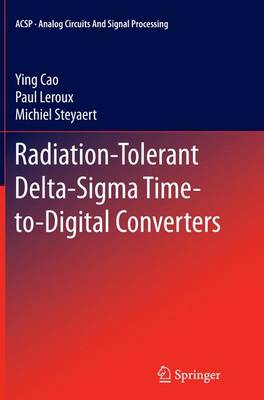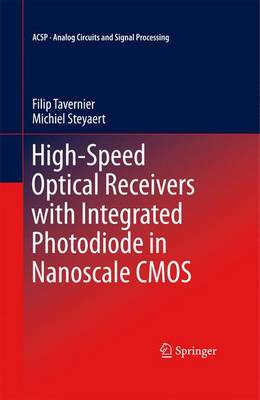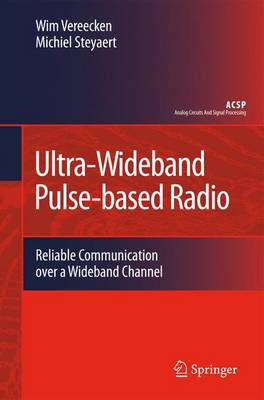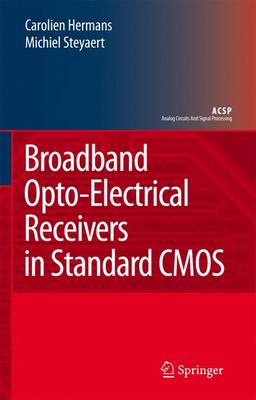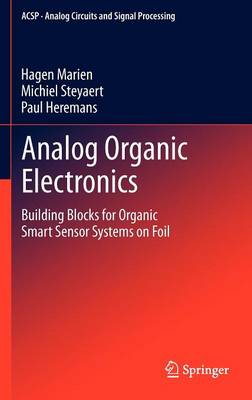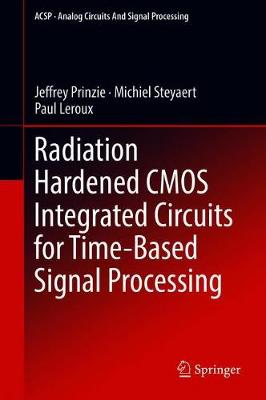Analog Circuits and Signal Processing
13 total works
Radiation-Tolerant Delta-Sigma Time-to-Digital Converters
by Ying Cao, Paul Leroux, and Michiel Steyaert
This book focuses on the design of a Mega-Gray (a standard unit of total ionizing radiation) radiation-tolerant ps-resolution time-to-digital converter (TDC) for a light detection and ranging (LIDAR) system used in a gamma-radiation environment. Several radiation-hardened-by-design (RHBD) techniques are demonstrated throughout the design of the TDC and other circuit techniques to improve the TDC's resolution in a harsh environment are also investigated. Readers can learn from scratch how to design a radiation-tolerant IC. Information regarding radiation effects, radiation-hardened design techniques and measurements are organized in such a way that readers can easily gain a thorough understanding of the topic. Readers will also learn the design theory behind the newly proposed delta-sigma TDC. Readers can quickly acquire knowledge about the design of radiation-hardened bandgap voltage references and low-jitter relaxation oscillators, which are introduced in the content from a designer's perspective.
* Discusses important aspects of radiation-tolerant analog IC design, including realistic applications and radiation effects on ICs;
* Demonstrates radiation-hardened-by-design techniques through a design-test-radiation assessment practice;
* Describes a new type of Time-to-Digital (TDC) converter designed for radiation-tolerant application;
* Explains the design and measurement of all functional blocks (e.g., bandgap reference, relaxation oscillator) in the TDC.
Design and Implementation of Fully-Integrated Inductive DC-DC Converters in Standard CMOS
by Mike Wens and Michiel Steyaert
EMC of Analog Integrated Circuits
by Jean-Michel Redoute and Michiel Steyaert
Environmental electromagnetic pollution has drastically increased over the last decades. The omnipresence of communication systems, various electronic appliances and the use of ever increasing frequencies, all contribute to a noisy electromagnetic environment which acts detrimentally on sensitive electronic equipment. Integrated circuits must be able to operate satisfactorily while cohabiting harmoniously in the same appliance, and not generate intolerable levels of electromagnetic emission, while maintaining a sound immunity to potential electromagnetic disturbances: analog integrated circuits are in particular more easily disturbed than their digital counterparts, since they don't have the benefit of dealing with predefined levels ensuring an innate immunity to disturbances. The objective of the research domain presented in EMC of Analog Integrated Circuits is to improve the electromagnetic immunity of considered analog integrated circuits, so that they start to fail at relevantly higher conduction levels than before.
High-Speed Optical Receivers with Integrated Photodiode in Nanoscale CMOS
by Filip Tavernier and Michiel Steyaert
Design of High Voltage xDSL Line Drivers in Standard CMOS
by Bert Serneels and Michiel Steyaert
This book fits in the quest for highly efficient fully integrated xDSL modems for central office applications. It presents a summary of research at one of Europe's most famous analog design research groups over a five year period. The book focuses on the line driver, the most demanding building block of the xDSL modem for lowering power.
The book covers the total design flow of monolithic CMOS high voltage circuits. It is essential reading for analog design engineers.
RF Power Amplifiers for Mobile Communications
by Patrick Reynaert and Michiel Steyaert
This book tackles both high efficiency and high linearity power amplifier (PA) design in low-voltage CMOS. With its emphasis on theory, design and implementation, the book offers a guide for those actively involved in the design of fully integrated CMOS wireless transceivers. Offering mathematical background, as well as intuitive insight, the book is essential reading for RF design engineers and researchers and is also suitable as a text book.
Broadband Opto-Electrical Receivers in Standard Cmos
by Carolien Hermans and Michiel Steyaert
This book opens with the basics of the design of opto-electronic interface circuits. The text continues with an in-depth analysis of the photodiode, transimpedance amplifier (TIA) and limiting amplifier (LA). To thoroughly describe light detection mechanisms in silicon, first a one-dimensional and second a two-dimensional model is developed. All material is experimentally verified with several CMOS implementations, with ultimately a fully integrated Gbit/s optical receiver front-end including photodiode, TIA and LA.
Variation-Aware Analog Structural Synthesis
by Trent McConaghy, Pieter Palmers, Peng Gao, Michiel Steyaert, and Georges Gielen
Analog Organic Electronics
by Hagen Marien, Michiel Steyaert, and Paul Heremans
This book provides insight into organic electronics technology and in analog circuit techniques that can be used to increase the performance of both analog and digital organic circuits. It explores the domain of organic electronics technology for analog circuit applications, specifically smart sensor systems. It focuses on all the building blocks in the data path of an organic sensor system between the sensor and the digital processing block. Sensors, amplifiers, analog-to-digital converters and DC-DC converters are discussed in detail. Coverage includes circuit techniques, circuit implementation, design decisions and measurement results of the building blocks described.
CMOS Integrated Capacitive DC-DC Converters
by Tom Van Breussegem and Michiel Steyaert
This book provides a detailed analysis of all aspects of capacitive DC-DC converter design: topology selection, control loop design and noise mitigation. Readers will benefit from the authors' systematic overview that starts from the ground up, in-depth circuit analysis and a thorough review of recently proposed techniques and design methodologies. Not only design techniques are discussed, but also implementation in CMOS is shown, by pinpointing the technological opportunities of CMOS and demonstrating the implementation based on four state-of-the-art prototypes.
Radiation Hardened CMOS Integrated Circuits for Time-Based Signal Processing
by Jeffrey Prinzie, Michiel Steyaert, and Paul Leroux
This book presents state-of-the-art techniques for radiation hardened high-resolution Time-to-Digital converters and low noise frequency synthesizers. Throughout the book, advanced degradation mechanisms and error sources are discussed and several ways to prevent such errors are presented. An overview of the prerequisite physics of nuclear interactions is given that has been compiled in an easy to understand chapter. The book is structured in a way that different hardening techniques and solutions are supported by theory and experimental data with their various tradeoffs.
- Based on leading-edge research, conducted in collaboration between KU Leuven and CERN, the European Center for Nuclear Research
- Describes in detail advanced techniques to harden circuits against ionizing radiation
- Provides a practical way to learn and understand radiation effects in time-based circuits
- Includes an introduction to the underlying physics, circuit design, and advanced techniques accompanied with experimental data
High-Ratio Voltage Conversion in CMOS for Efficient Mains-Connected Standby
by Hans Meyvaert and Michiel Steyaert
This book describes synergetic innovation opportunities offered by combining the field of power conversion with the field of integrated circuit (IC) design. The authors demonstrate how integrating circuits enables increased operation frequency, which can be exploited in power converters to reduce drastically the size of the discrete passive components. The authors introduce multiple power converter circuits, which are very compact as result of their high level of integration. First, the limits of high-power-density low-voltage monolithic switched-capacitor DC-DC conversion are investigated to enable on-chip power granularization. AC-DC conversion from the mains to a low voltage DC is discussed, enabling an efficient and compact, lower-power auxiliary power supply to take over the power delivery during the standby mode of mains-connected appliances, allowing the main power converter of these devices to be shut down fully.
